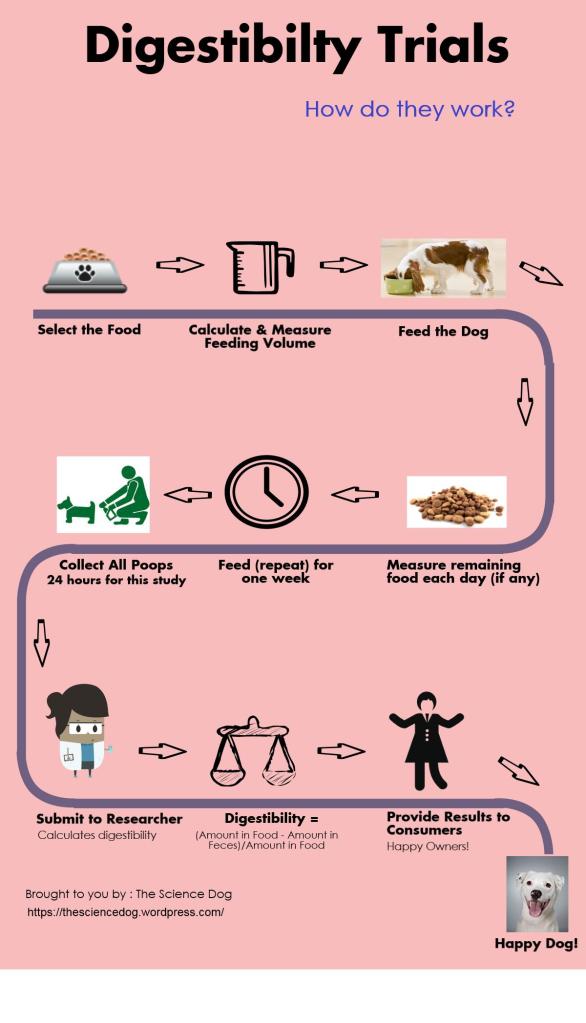In recent years, the expansion of citizen scientist experiments to include owners and their dogs has been instrumental in furthering our understanding of canine behavior, social cognition, emotional responses and training. Not only are these studies of great practical importance, they also provide information about the complexities of dogs lives in ways that laboratory experiments cannot achieve. Some specific areas of study that have used dogs living in homes include dogs’ preferences, cognitive biases, stress responses during veterinary visits, responses to nose work training, pointing gestures, referential gestures, emotional responses to teasing, and many more.
Canine Nutrition and Feeding?
Although rather slow to board the in-home studies train, a few nutritionists have started to recruit citizen scientists and their dogs for feeding studies. These studies have provided data regarding dogs’ taste preferences, their interest in food-delivery toys, and most recently, specific aspects of the canine skin microbiome. However, although others have promoted its use, one type of study that has not yet made it into the realm of the citizen scientist is the dog food digestibility trial.
This is surprising seeing that digestibility studies are relatively simple and easy to conduct and are safe for dogs (i.e. only balanced foods are tested). They are literally, as easy as scooping poop.
How is Digestibility Measured (and Where)?
Without question, one of the most important measures of a food’s quality is its digestibility – the proportion of the food that a dog’s gastrointestinal tract is able to actually break down (digest) and absorb. Digestibility values correlate well with both ingredient quality and proper food processing techniques. Therefore, having an idea of a food’s digestibility is essential for selecting quality foods and feeding our dogs well.
Traditionally, food digestibility is measured by pet food companies using small groups of kenneled dogs and following feeding protocols dictated by the Association of American Feed Control Officials (AAFCO) or in Europe and the UK, by the European Pet Food Industry Federation (FEDIAF). Overall, the procedure for testing digestibility is pretty simple. It involves feeding the food (and only that food) and collecting the feces that the dog produces whilst consuming the food. Here is a diagram that summarizes the primary steps:
Using In-Home Feeding Studies
A few years ago, researchers in the Netherlands brought in citizen scientists to conduct a set of digestibility trials with dogs living in homes (1). They found that indeed, having pet owners participate with their dogs was an effective and reliable approach to collecting digestibility data. Unfortunately, we did not see a rush by pet food companies to use this approach after the paper’s publication. (Sigh). Regardless, we can consider that this first study was a Proof of Concept paper demonstrating the feasibility of running Citizen (Dog) Scientist Digestibility Trials.
This year, the same group of nutritionists expanded this work (2). They enlisted a larger group of dog owners and focused on the important task of validating a protocol for in-home digestibility trials.
The Study
A group of 60 healthy adult dogs, of varying breeds and ages, were recruited. Two complete and balanced, extruded (dry) dog foods were tested, using a cross-over study design. The foods were produced by a commercial pet food company (Jonker Petfood). Food A was formulated to have high digestibility while Food B was formulated to have slightly lower digestibility values. Owners fed their dogs each food, and only that food for a seven-day period. They then switched to the alternate food. Feces were collected daily by the owners and submitted for analysis. Detailed feeding and lifestyle diaries were kept during the test periods. Digestibility values (dry matter, protein, fat, etc.) were calculated for days 2 to 7 in each period.
Results:
Of the group of 60 dogs that started the trial, 53 completed the entire study (completion rate of 88 %). For the majority of dogs, switching to each of the two foods did not lead to any adverse gastrointestinal effects.
- Digestibility values: Although feces were collected througout each seven-day feeding period, statistical analysis showed that digestibility values for all nutrients were stable between day 2 and day 7 of feeding. This means that only one full day of adaptation to a new food was needed for the dogs’ gastrointestinal tracts to reach a steady state in digesting the new food.
- Variability among dogs: As expected, the digestibility of Food A was slightly higher than that of Food B. This different was consistent for all of the measured nutrients. Male dogs and neutered dogs tended to have slightly higher digestibility values than females and intact dogs, respectively, and an age effect was found for some nutrients.
- Feces Collection Days: Only a single day of complete feces collection was needed for reliable and consistent measures of digestibility.
- Number of Dogs: Depending somewhat on the nutrient of interest, the authors estimated that between 9 and 43 dogs should be enrolled in in-home digestibility trials to allow for appropriate levels of statistical power when analyzing data and/or comparing foods.
Take Away for Dog Folks
The investigators were interested in creating an in-home feeding study protocol that could be used as a standard for measuring dog food digestibility values. The results show that in-home digestibility trials can be designed that require a reasonable time and effort commitment of owners and that provide reliable results. In other words, if an owner who is interested in participating with their dog is told that they will need to feed the food (and only that food) for a week, during which time they collect and submit their dogs feces for one or two days, this is not a high bar to clear for most owners. One would expect that compliance would be high and that many owners would be interested in participating as Citizen Scientists, given the relatively low amount of time and work involved.
There are many advantages to in-home digestibility tests when compared with the traditional tests conducted with small numbers of kenneled dogs. (Not to put too fine a point on this, but AFFCO protocols require that only six dogs are fed the food in question for a digestibility trial). Just a few of these are:
- Study the Dogs We are Actually Feeding: By definition, these tests are measuring digestibility values in the population of dogs who are actually being fed the foods. It has often been argued that using data collected from a small group of dogs, usually of a single breed, that are housed in kennels may not be representative of dogs who live in homes.
- Lifestyle Influences: Second, the increased number of dogs available for in-home trials can allow nutritionists to explore the potential influences of lifestyle, age, life stage, living situation, and even breed. Just as with behavior and cognition, the complexities of nutrient use and metabolism may be better studied with dogs who live in homes.
- Owner Contributions: Including owners in these studies provides an entirely new and helpful pool of data – owners can keep daily diaries of their dog’s enjoyment of the foods, feeding behavior, activity level and subjective evaluations of their dog’s energy level and feces quality.
All around, scooping some poop for an in-home digestibility study can lead to better information about the foods that we feed and, hopefully will further increase transparency in the pet food industry. So, if you are already scooping for your dog, consider the benefits of scooping for science! Hopefully, pet food companies will step up and begin to use the information provided by this new study to test (and improve upon) their foods and provide a new scoop for citizen scientists with dogs!
Cited Studies
- Hagen-Plantinga EA, Bosch G, Hendriks WH. Practical approach to determine apparent digestibility of canine diets. Journal of Nutritional Science 2014;3;e31:1-4.
- Bos E, Hendriks WH, Beerda B, Bosch G. Determining the protocol requirements of in-home dg food digestibility testing. British Journal of Nutrition 2022; In Press.






